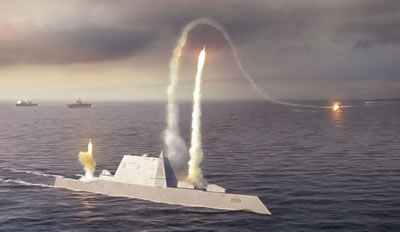DDG 1000 is the first in a class of the U.S. Navy’s multi-mission surface combatants tailored for land attack and littoral dominance. The ship’s mission is to provide affordable, credible, independent forward presence and deterrence and to operate as an integral part of naval, joint or combined maritime forces. DDG 1000 will provide advanced land attack capability in support of ground campaigns and will contribute naval, joint or combined battlespace dominance in littoral operations. DDG 1000 is in an advanced state of development and will influence ship design worldwide for the remainder of the century.
Each DDG 1000 will carry 20 VLS missile launchers distributed along the periphery of the ship. These launchers could be loaded with Tomahawk land attack cruise missiles (TLAM), and Evolved Sea Sparrow Missiles (ESSM) and Standard type air defense missiles. The MK57 features an open architecture, modular electronics design that provides a significant advantage for the integration of new missile systems without requiring modification of the launcher control software. This design will result in faster, more efficient system upgrades, as well as save significant costs and time for the Navy. raytheon and BAE Systems demonstrated the first test firing of MK57 system in February 2007.
On January 2007 the U.S. Navy awarded over half billion US$ for continued detailes design of the Zumwalt class destroyer, DDG-1000. Northrop Grumman Corporation (NYSE: NOC) was awarded US$268 million and General Dynamics’ Bath Iron Works was awarded $257 million, bringing the total value spent on the new class’ design to $644 million. The contract funds further DDG 1000 detail design and procurement of vendor-furnished information and long-lead materials and runs through 2013.
By February 2007 Raytheon was awarded about US$300 million contract to support the development of the vessel’s Mission System Equipment (MSE). In addition to the Mark 57 Vertical Launcher System, the MSE includes the ship’s computing environment infrastructure; acoustic sensor suite elements, such as the bow array sensor suite; dual band radar; electro-optic/infrared sensor; ship control system; identification of friend or foe; common array power and cooling systems and various electronic module enclosures.
On April 24 2007 BAE Systems received an additional US$109 million award to complete the design, development and integration of the Advanced Gun System (AGS) weapon for the Zumwalt destroyer (DDG 1000). Two years ago (In May 2005) the company (then, United Defense) received $376 million to begin the development of the gun, a fully automated, single barrel, 155-mm, vertically loaded, stabilized gun mount that will be capable of firing programmable, guided Long Range Land Attack Projectiles. The gun will enable the vessel engaged in littoral warfare to attack land targets from safe stand-off distance over the horizon, and support ground and expeditionary forces beyond line-of-sight. The gun system will include fully automated gun, and automatic loading magazine containing the Long Range Land Attack Projectiles (LRLAP). According to the original schedule, development is expected to complete by 2010.
Under the Navy’s DDG 1000 Design, Development and Integration contract awarded in 2005, Raytheon IDS serves as the prime mission systems equipment integrator for all electronic and combat systems for the DDG 1000 program. BAE Systems serves as the design agent for the MK57 and is responsible for building the launcher for the DDG 1000 destroyer.

















